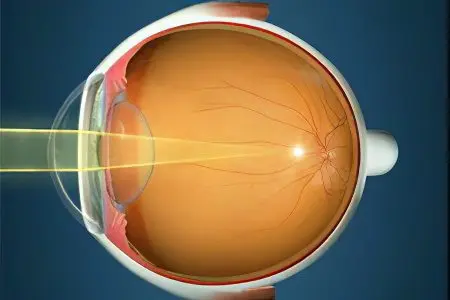Contents

Myopia 1 degrees – this is an anomaly of refraction, expressed in a deterioration in the vision of objects located in the immediate distance. This condition occurs due to the fact that the focus of the light rays does not occur on the retina, but in front of it. If a person is diagnosed with 1 degree of myopia, then this indicates that his refractive error does not exceed 3 diopters.
Statistics provided by WHO indicate that myopia is a fairly common disease. Up to 30% of the world’s population experience similar vision problems. It is from myopia of a weak degree that the vast majority of patients suffer. Their share in the total mass of people with myopia is 80%. At the same time, it was found that every fifth student experiences symptoms of myopia of the first degree.
Symptoms of myopia 1 degrees
Among the symptoms indicating that a person is developing mild myopia, the main one can be distinguished – this is a deterioration in the vision of objects located far away. At the same time, the contours of objects are visible, and a person can distinguish them, however, they will be somewhat blurry and fuzzy.
Other symptoms include the following:
The appearance of pain, which can be localized in the temples, eye sockets, forehead.
Rapid fatigue of the organs of vision.
Increased dryness of the mucous membrane of the eyes.
Squinting of the eyes when trying to look into the distance.
Redness of the mucous membrane of the eyes, due to the expansion of capillaries.
Often, these symptoms can be found in children who have begun attending school. This is due to the increased load on the eyes. Therefore, it is important to be extremely attentive to your own child, since he may not make any complaints to his parents, perceiving such a state as a variant of the norm. Often, first-degree myopia is asymptomatic, and it can only be detected during a scheduled visit to an ophthalmologist. If the distance from the focus to the retina does not exceed more than 1 diopter, then ophthalmologists speak of a spasm of accommodation.
Spasm of accommodation is a temporary visual disturbance, as a result of prolonged stress on the ciliary muscle of the eye. It is dangerous because if you do not pay attention to such a condition in time, it can lead to the appearance of stable myopia.
Causes of myopia 1 degrees
Among the main reasons for the development of mild myopia are the following:
Poor heredity, that is, the possibility of the disease passing from parents to children. This is especially true when both mother and father suffer from myopia.
Increased stress on the eyes. The most dangerous from the point of view of the development of myopia is the situation when a person loads them with work with objects at close range. We are talking about reading books, writing, working at a computer, watching TV, etc.
Congenital features of the organ of vision. These include an increase in the length of the eyeball and its deformation.
Inconsistency of convergence and accommodation, as a result of non-observance of visual hygiene. For example, reading in a prone position, in a moving vehicle, visual work in low light, etc. All this leads to the development of pseudomyopia, which later often develops into a true one.
Transferred infectious diseases: measles, influenza, scarlet fever, tonsillitis, etc.
Craniocerebral injury.
Types of myopia
As for the varieties of first degree myopia, it can be progressive and non-progressive. The latter type does not require special therapy and is successfully corrected by wearing glasses, as it does not cause fundus anomalies.
Progressive myopia of the first degree is dangerous because with the development of the disease it can lead to many complications and even complete blindness.
Diagnostics
In order to establish the diagnosis of mild myopia, the doctor will need to conduct a series of ophthalmological tests. This is color testing, and a refraction test, and perimetry. A visual examination of the structure of the eye will also be required.
In some cases, the ophthalmologist may refer the patient to an ultrasound of the eye, for example, if progressive myopia is suspected, which caused retinal detachment, if it is impossible to conduct a standard ophthalmological examination, and for other indications.
To determine myopia, it may be necessary to study refraction by skiascopy or computer refractometry.
Treatment of myopia 1 degrees

Glasses. In order to avoid the progression of the disease, when detecting myopia of the 1st degree, vision correction is necessary with the help of glasses with negative lenses. They contribute to the fact that refraction is normalized and a person becomes able to equally well consider both near and distant objects. There is no need to wear glasses all the time. They will need to be removed when a person with a mild degree of myopia works with objects at a close distance – reading or writing. Contact lenses can be used as a substitute for glasses. However, they have restrictions, for example, age.
Exercises. As additional methods of treatment, doctors recommend performing a certain set of exercises aimed at strengthening the eye muscles. They should definitely be performed by preschoolers and schoolchildren, since their visual apparatus is just being formed.
Hardware treatment. Hardware treatment can be prescribed, for example, with Sidorenko Glasses, which stimulate the organ of vision with the help of sound and color impulses, perform phonophoresis and pneumomassage. Due to such a complex effect, it is possible to achieve normalization of blood supply and strengthening of the ciliary muscle, to increase the effectiveness of the medications taken.
Vitamins. Supplement the main treatment with vitamin therapy, massage of the collar zone, proper nutrition. Every day, a person with myopia of the first degree should receive B vitamins, as well as microelements such as manganese, chromium, copper, selenium and others.
Author of the article: Degtyareva Marina Vitalievna, ophthalmologist, ophthalmologist









